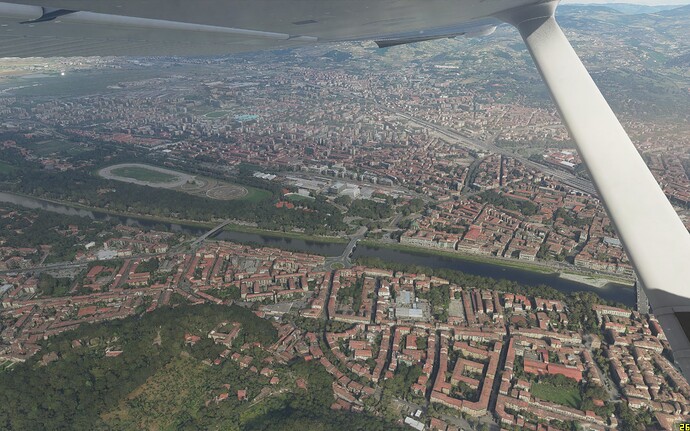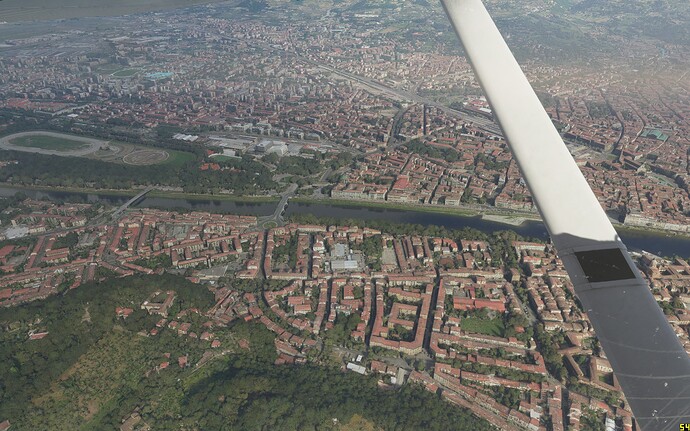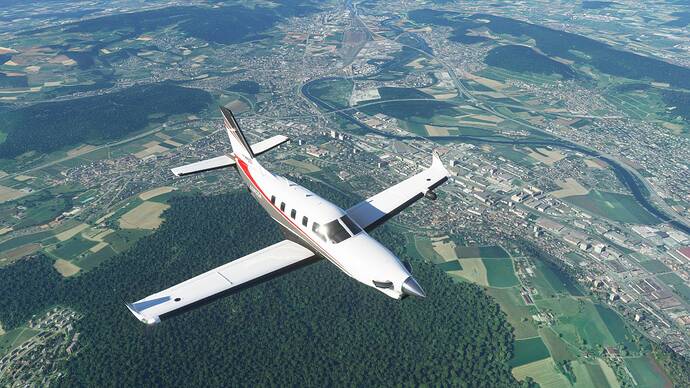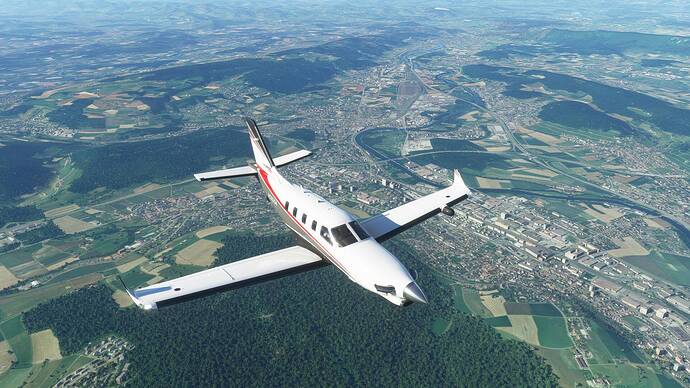I realize if one reduces render scaling, you get better performance, but what exactly does this accomplish? Less detail, less autogen, less detailed ortho, smaller buildings?
Lower resolution, effectively. You render at a lower resolution, then scale that image up to the monitor’s resolution. So visually you might get more jaggies and/or a blurrier image.
Render scaling above 100 renders at a higher resolution, then scales down, effectively giving you supersampled antialiasing.
Essentially it draws the game at a higher (Or smaller) resolution than you have the monitor resolution\game res set to and then the game squeezes it back down.
So if you’re rendering at 200%, the game will render at double your resolution, but then scale it back down to your monitor res. It’ll look better, but performance will hurt.
I tried render scaling at 200% on 4K and ended up at 1-3 FPS! Back at 100% and looking fine just like that.
Turned render scaling to 200% and immediately game closed. I have an i7 with a nvidia ti1080 and 32 gb of ram. Hopefully they fix this asap.
Why would they fix this, what resolution were you trying to run at. A 1080Ti could not render at 8K for example if yoiu were trying 200% at 4K
There is nothing to “fix.” ![]()
Render scaling quite literally means the internal, rendered, resolution of the game before it gets downscaled/upscaled to your set resolution - ideally your monitors native resolution.
So if your screen resolution is set to 1920x1080 and you use 100% - the game is rendered and displayed at 1920x1080.
If resolution is 1920x1080 and you opt for 200% resolution - the game is rendered at 4K and then downscaled to 1080p.
What this is meant to do is be able to offer a higher appearance of the game to offload additional effects that have diminishing returns once resolution is increased leaving the GPU to have more processing pushed to rendering a particular game.
Going back to the 1080p with 200% scaling to get an effective 4K image - you can then turn down/off some effects such as AA because with an increased resolution tends to hide aliased edges of objects much better. Depending on the AA technique used - may increase overall performance and appearance because at higher resolutions its harder to see these jagged edges so why bother dedicating ‘horsepower’ to something that is imperceptible?
IMO - if you don’t have a beefy GPU at all… never go above 100% scaling of your monitors native resolution.
The opposite is also true… if your native screen resolution is 4K but you don’t have the GPU power to run games at 4K - you get the scaling to 50% and you’ll be rendering the game at 1080p instead so you’ll have an increase in performance.
I’ve been playing with the Render scaling settings to see what impact I got at various levels. I’m running a 4K display and an RTX 2070 SUPER. At 100% scaling the performance of the sim was OK but it sat around 30FPS and would drop to 20-22FPS in complex areas. The resulting simulation became a little choppy. 50% Render scaling gave me a great boost in FPS up to about 50-60FPS but there was a distinct degredation of the visuals. Ive settled at 70% and about 40-50FPS which still gives great visual acuity to the scenery at 4K. This allows a little bit of room for some drops at complex places like London and Heathrow. It also allowed me to boost some of the other settings up a notch.
Absolutely correct reply. I only want to add that “doubling” means 4 times more pixels to render, and quadrupling (renderscale 400) would mean 16 times more pixels. The total number of pixels is equal to the square of the value, that’s why the fps impact of an increase is not linear but exponential. Unfortunately ..
Essentially, you will need a 4 times more powerful GPU to render at 200 instead 100. Most high-mid range cards have reserves and can run anything up to to 150 without a major impact but 200 will be a bit too demanding.
I personally run around 120, sometimes 130 (GTX1070). It is a nice feature that makes cruder solutions (NVIDIA DSR) obsolete and makes the image sharper.
And yes, when the next generation of cards arrives in 2021 we will be able to run this and and other costly image improvement without much consideration, but it is not absolutely necessary.
Here are two shots (2650x1600, RTX 3080, ryzen 3700X), one with render scaling at 200% and 26 FPS, the second with render scaling at 120% and more than double FPS : 54.
Apart from the obvious FPS factor, I don’t see nothing that makes those two images different.
Am I missing something here ?
This is already a high resolution. The higher render scale will be more noticeable at 1080P.
So yes, at higher resolutions, it doesn’t really add anything, perhaps slightly better looking AA.
It depends on your native resolution, but if you’re running 1440p or above, all it does it slow down performance with no detectable visual improvement to justify it. Leave it at 100% and forget about it.
There’s a noticeable improvement in visuals when running at 1080P and setting the render scale to something like 150%. Especially in smaller things like distant buildings, or reading gauges in the cockpit. Before the TAA fix, I couldn’t read the G meter in the 152 Aerobat unless I ran at 150% resolution scaling.
That being said, the new TAA Sharpening algorithm that came into play a couple versions ago, really helps out alot, so 100% looks alot better than it used to. I’d say it looks decent now, before I didn’t think it looked very good and said that 150% scaling is basically required. With the current version, if I were running a 4K monitor, I bet 80% scaling would look about perfect.
I’d agree though, if you’re playing at 1440p or 4K, the difference is less obvious than running at a low resolution like 1080p.
Pretty sure Render Scaling is more designed for running slightly lower res on high-density panels to improve performance, rather than running extra res at lower resolutions as some kind of brute force supersampling.
For example, I’m running @4k on a 1080ti - I set Render Scaling to 80% - that results in only 64% of the pixel count of a true 4k presentation with very little drop in visual fidelity. (because 0.8 * 0.8 = 0.64) So that increases performance a lot at little visual cost.
Turning it above 100% only makes sense for extremely high-end graphics cards with lots of VRAM running low resolutions. In almost all other circumstances, there are going to be better ways to ‘spend’ your performance in the options than running brute force over-res.
I used the very straightforward Digital Foundry oprimisation settings for my card & res & haven’t had to change settings since:
Here is rendering scale@100 on native 1440p
Native 1080p 100 rendering scale
Only difference I’ve seen is slightly clearer visuals on 1440p
Yes, I eventually settled on 7O%, getting a significant fps boost without much empact on the scenery. Unfortunately I then tried a flight in the Cessna Citation, and found I couldn’t read the displays without zooming in on them. I hadn’t realised it was affecting the cockpit as well as the exterior view, and the downgrade to the cockpit was far more objectionable.
So now I’m not sure what setting to use. I may have to set it according to the plane and the location.
it’s not too hard, if you’re on 1080P, you want it a bit above 100% (if your system can cope)
if you’re on 1440P, keep it on 100%
if you’re on 4K, you might want to drop it below 100% to help with performance.
Let me guess you’re on 4k? no issues keeping on 70 or 80
No, 1080P.
With preset forward view, I can read data on the Citation Garmin at 100, but not at 70. But this is at the expense of 5-10fps.




